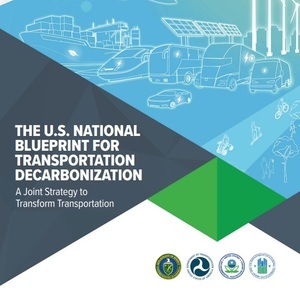DOE releases blueprint to decarbonize US transportation

January 11, 2023
BY Erin Krueger
The U.S. Department of Energy on Jan. 10 released the U.S. National Blueprint for Transportation Decarbonization, which describes a strategy for achieving net-zero emissions in the transportation sector by 2050. The blueprint, in part, discusses the role sustainable fuels can play in achieving that goal.
The blueprint was developed in partnership by the DOE and the U.S. Department of Transportation, the U.S. Department o Housing and Urban Development and the U.S. EPA. It represents the first milestone deliverable of the memorandum of understanding (MOU) signed by the four agencies in September 2022. According to the DOE, the blueprint will be followed by more detailed decarbonization action plans, to be developed and implemented by the four federal agencies in cooperation with governments at the state, local and Tribal level; philanthropic organizations; the private sector; and global partners.
The U.S. transportation sector, which includes all modes of travel through land, air and sea to move people and goods, currently accounts for one-third of all domestic greenhouse gas (GHG) emissions. The DOE also notes that transportation costs are the second largest annual household expense in the U.S. According to the agency, a well-planned transition to a decarbonized transportations system will provide equitable, affordable and accessible options for moving people and goods. The DOE also noted that further developing and deploying clean-energy technologies, including electric vehicles, hydrogen and sustainable fuels, will create good-paying jobs in all segments of the transportation sector while strengthening America’s energy independence.
Advertisement
Advertisement
The blueprint shows that the production of sustainable liquid fuels offers strong long-term opportunities for aviation and maritime transportation. Sustainable liquid fuels also offer strong potential for reducing emissions in rail, heavy trucking, and off-road applications. According to the blueprint, the DOE and its partner agencies have not yet determined the potential long-term opportunities for the use of sustainable liquid fuels in light duty vehicles or pipeline applications.
The blueprint also points out that sustainable liquid fuels also have the potential to help decarbonize the plastics/chemicals sector while creating opportunities for biobased products. Research, development and demonstration (RD&D) priorities for sustainable liquid fuels include multiple cost-effective drop-in sustainable fuels, reduced ethanol carbon intensity, and bioenergy scale-up, according to the blueprint.
Advertisement
Advertisement
Withing the blueprint, the DOE and its partner agencies stress that sustainable liquid fuels provide the same advantages and flexibility as petroleum fuels, making them particularly well-positioned to decarbonizing aviation and international maritime shipping, as well as legacy vehicles. The DOE’s Bioenergy Technologies Office estimates that more than 50 billion gallons of sustainable fuels (80 percent or more GHG emission reduction) can be cost-effectively produced domestically by leveraging multiple production pathways. That volume would be enough to fully supply aviation, maritime and rail demand in 2050, according to the DOE.
A full copy of the blueprint can be downloaded from the DOE website.
Related Stories
The USDA significantly increased its estimate for 2025-’26 soybean oil use in biofuel production in its latest World Agricultural Supply and Demand Estimates report, released July 11. The outlook for soybean production was revised down.
The U.S. Energy Information Administration maintained its forecast for 2025 and 2026 biodiesel, renewable diesel and sustainable aviation fuel (SAF) production in its latest Short-Term Energy Outlook, released July 8.
XCF Global Inc. on July 10 shared its strategic plan to invest close to $1 billion in developing a network of SAF production facilities, expanding its U.S. footprint, and advancing its international growth strategy.
U.S. fuel ethanol capacity fell slightly in April, while biodiesel and renewable diesel capacity held steady, according to data released by the U.S. EIA on June 30. Feedstock consumption was down when compared to the previous month.
XCF Global Inc. on July 8 provided a production update on its flagship New Rise Reno facility, underscoring that the plant has successfully produced SAF, renewable diesel, and renewable naphtha during its initial ramp-up.
Upcoming Events










